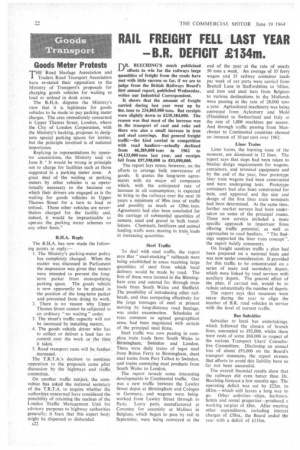RAIL FREIGHT FELL LAST YEAR Um DEFICIT £134m.
Page 24

If you've noticed an error in this article please click here to report it so we can fix it.
DR. BEECHING'S much publicized efforts to win for the railways large quantities of freight from the roads have met with little success so far, if we are to judge from the British Railways Board's first annual report, published Wednesday, Writes our Industrial Correspondent.
It shows that the amount of freight carried during last year went up by 6m, tons to 234,865,000 tons. But receipts were slightly down to £235,384,000. The reason was that most of the increase was in the transport of coal and coke and there was also a small increase in iron and steel carryings. But general freight traffic—the kind carried in competition with road hauliers—actually declined from 46,289,000 tons in 1962 to 44,133,000 tons last year, and receipts fell from £97,598,000 to 193,090,000.
The report lays stress, however, on the efforts to arrange bulk conveyance of goods. It quotes the long-term agreements with six major oil companies which, with the anticipated rate of increase in oil consumption, is expected to bring to the railways over the next 10 years a minimum of 80m. tons of traffic and possibly as much as 120m. tons. Agreements had also been concluded for the carriage of substantial quantities of cement, sand and gravel to bulk installations. Chemicals, fertilizers and animal feeding stuffs were moving in train loads in increasing quantities.
Steel Traffic To deal with steel traffic, the report says that " steel-stocking " railheads were being established in areas receiving large quantities of steel from which local delivery would be made by road. The first of these were located in the Birmingham area and catered for through train loads from South Wales and Sheffield. The possibility of introducing other railheads, and thus competing effectively for the large tonnages of steel at present moving by long-distance road haulage, was under examination. Schedules of rates common to agreed geographical areas had been negotiated with certain of the principal steel firms.
Steel traffic was now passing in complete train loads fsom South Wales to Birmingham; Swindon and London. There were daily trains of ingot steel from Briton Ferry to Birmingham, sheet steel trains from Port Talbot to Swindon, and trains conveying steel products from South Wales to London.
The report reveals some interesting developments in Continental traffic. One was a new traffic between the Lawley Street depot at Birmingham and Cologne in Germany, and wagons were being worked from Lawley Street through to Paris. Lorry parts manufactured at Coventry for assembly at Malines in Belgium, which began to pass by rail in September, were being conveyed at the
end of the year at the rate of nearly 50 tons a week. An average of 35 ferry wagon and 35 railway container loads per week of car parts were carried from Brettell Lane in Staffordshire to Milan, and iron and steel bars from Belgium to various destinations in the Midlands were passing at the rate of 28,000 tons a year. Agricultural machinery was being conveyed from Aylesbury and Mold (Flintshire) to Switzerland and Italy at the rate of 1,000 machines per season. And through traffic passing from Manchester to Continental countries showed an increase of 10 per cent over 1962.
Liner Trains
Liner trains, the burning issue of the moment, are dismissed in 12 lines. The report says that steps had been taken to finalize design requirements for wagons, containers, and terminal equipment and by the end of the year, four prototype liner train wagons had been constructed and were undergoing tests. Prototype containers had also been constructed for tests, and approval and the size and design of the first liner train terminals had been determined. At the same time, further market surveys had been undertaken on some of the principal routes. These new surveys included a more specific approach to important firms offering traffic potential, as well as approaches to road hauliers. "The findings supported the liner train concept ", the report baldly comments.
On freight sundries traffic a plan had been prepared on a national basis and was now under consideration. It provided for this traffic to be concentrated on a series of main and secondary depots, which were linked by road services with auxiliary depots. The general effect of the plan, if carried out, would be to reduce substantially the number of depots.
The report says that measures were taken during the year to align the number of B.R. road vehicles in service with the level of current traffic.
Bus Subsidies Subsidies to local bus undertakings, which followed the closure of branch lines, amounted to £92,000, whilst there were costs of some £60,000 in respect of the various Transport Users' Consultative Committees. Disclosing an annual loss of about £93,000 on the Board's transport museums, the report stresses that efforts to avoid this liability have so far not been successful.
The overall financial results show that the railways did even better than Dr. Beeching forecast a few months ago. The operating deficit was cut by £22m. to £82m.—which still leaves a long way to go. Other activities—ships, harbours, hotels and rental properties—produced a working surplus of £8m. After meeting other expenditures, including interest charges of £58m., the Board ended the year with a deficit of £134m.




















































































































